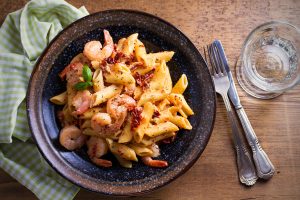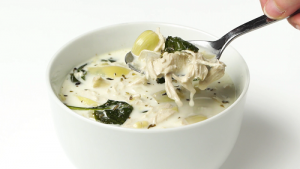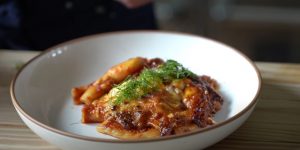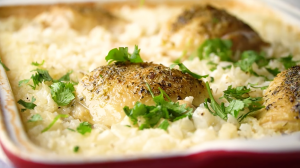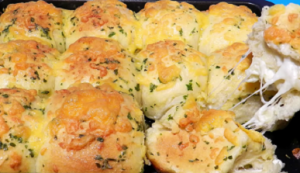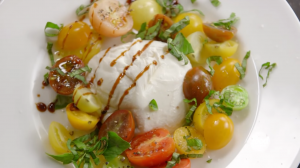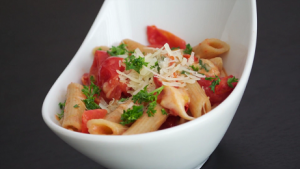Packed with flavor and heart-healthy nutrients, Chicken Florentine Pasta is a dish that your tastebuds will love and your body will thank you for. Imagine succulent chicken breast and fresh spinach melded together in a rich, creamy homemade pesto alfredo sauce, all tossed with penne pasta and topped with a sprinkle of Romano cheese. Healthy, hearty and absolutely scrumptious, this is a pasta dish that will surely impress.
Most of the ingredients needed for this recipe are pantry staples. However, you may need to take a trip to the supermarket for fresh spinach, Romano cheese, and pesto. While you can use store-bought pesto, homemade pesto truly elevates the flavor of the dish. Additionally, Romano cheese might not be in your everyday cheese repertoire, but its nutty and slightly sharp flavor provides a perfect finishing touch.
Chicken Florentine Pasta Ingredients
Olive oil: Used to cook the garlic and chicken. Its fruity flavor adds an extra layer of taste.
Garlic: Adds a robust flavor to the dish and is known for its numerous health benefits.
Chicken breast: The key protein in this dish. It's lean, healthy, and absorbs the flavors of the sauce beautifully.
Spinach leaves: Adds a nice contrast to the creamy sauce and a punch of nutrients.
Penne pasta: Its tubular shape holds the sauce well, offering a burst of flavor with every bite.
Romano cheese: A hard, salty cheese that adds a delectable flavor punch.
Chicken broth: Used in the alfredo sauce for added flavor.
Half and half: Gives the alfredo sauce its rich, creamy texture.
Whipping cream: Adds a velvety smoothness to the alfredo sauce.
Parmesan cheese: Brings a nutty and salty flavor to the alfredo sauce.
Pesto: Infuses the alfredo sauce with a bold, herby taste.
Salt and pepper: Essential seasonings that enhance the overall flavor of the dish.
One reader, Doretta Randolph says:





This chicken florentine pasta recipe is a game-changer! The flavors are out of this world, and the creamy pesto alfredo sauce is simply divine. The combination of tender chicken, fresh spinach, and perfectly cooked penne pasta is a match made in heaven. It's a must-try for any pasta lover!
Key Techniques for Perfecting Chicken Florentine Pasta
How to sauté chicken and spinach: Sauté garlic in hot oil for 1 minute, then add chicken and cook for 7 to 8 minutes on each side. Once the chicken is cooked through, add the spinach and sauté together for 3-4 minutes.
How to prepare alfredo sauce: Sauté garlic for 1 minute, then add broth and let it bubble. Add half & half, whipping cream, salt, and pepper, and parmesan cheese. Whisk constantly until combined. Allow the liquid to heat up and thicken for a few minutes. Once the sauce has reached the desired thickness, add 2 tablespoons of pesto sauce and set aside.
How to cook pasta: Cook the pasta according to the package directions, then rinse it under cool water and let it drain.
How to assemble the dish: Add the chicken and spinach mixture to the cooked pasta, then stir in the pesto alfredo sauce. Mix well and top with romano cheese before serving.
How To Make Chicken Florentine Pasta
You only need 35 minutes to whip up this lusciously creamy and cheesy chicken florentine pasta! It’s served with hearty spinach for an added healthy bite.
Serves:
Ingredients
- 2tbspolive oil
- 2tspgarlic
- 4chicken breast,boneless skinless, halved and cut into strips
- 2cupfresh spinach leaves
- 16ozdry penne pasta
- 1tbspromano cheese,grated
For Homemade Pesto Alfredo Sauce:
- 1cupchicken broth
- 1cuphalf and half
- ½cupwhipping cream
- 1cupparmesan cheese
- ½tspgarlic
- 2tbsppesto
- salt and pepper,to taste
Instructions
-
In a large skillet, sauté the garlic in hot oil for 1 minute. Add the chicken and cook for 7 to 8 minutes on each side.
-
Once the chicken is cooked through, add the spinach and sauté together for 3 to 4 minutes.
-
Cook pasta according to package directions. Rinse under cool water and let drain.
Homemade Pesto Alfredo Sauce:
-
Add the garlic to a separate pan and sauté for 1 minute. Add the broth, then let bubble. Then, add the half and half, whipping cream, salt and pepper and parmesan cheese
-
Whisk constantly until combined. Allow the liquid to heat up and thicken for a few minutes. Once the sauce has reached the desired thickness, add 2 tablespoons of pesto sauce. Set aside.
-
Add the chicken/spinach mixture to the pasta and stir in the Pesto/Alfredo sauce. Mix well, then top with Romano cheese.
-
Serve, and enjoy!
Nutrition
- Calories: 772.68kcal
- Fat: 36.28g
- Saturated Fat: 15.35g
- Trans Fat: 0.12g
- Monounsaturated Fat: 13.21g
- Polyunsaturated Fat: 3.79g
- Carbohydrates: 62.88g
- Fiber: 3.02g
- Sugar: 5.24g
- Protein: 46.73g
- Cholesterol: 131.20mg
- Sodium: 791.50mg
- Calcium: 420.16mg
- Potassium: 635.62mg
- Iron: 2.73mg
- Vitamin A: 222.73µg
- Vitamin C: 3.74mg
Pro Tip for Elevating Your Chicken Florentine Pasta
When preparing the pesto alfredo sauce, it's crucial to whisk the ingredients constantly. This not only ensures that the ingredients are well combined, but it also prevents the sauce from burning at the bottom of the pan. Additionally, allowing the sauce to heat up and thicken for a few minutes will result in a creamier and richer texture. Remember, the key to a perfect alfredo sauce is patience and constant stirring.
Time-Saving Tips for Preparing Chicken Florentine Pasta
Prep ahead: Chop vegetables, marinate meat, and prepare sauces in advance to save time during the cooking process.
One-pot wonders: Opt for recipes that allow you to cook everything in a single pot or pan to minimize cleanup time.
Batch cooking: Make larger portions and freeze the extra for quick and easy meals on busy days.
Kitchen organization: Keep your kitchen well-organized to easily locate ingredients and cooking tools, saving time and reducing stress.
Time-saving gadgets: Utilize kitchen gadgets like food processors, slow cookers, and pressure cookers to streamline meal preparation.
Efficient multitasking: Plan your cooking process to multitask effectively, such as boiling water while chopping vegetables.
Substitute Ingredients For Chicken Florentine Pasta Recipe
Olive oil - Substitute with avocado oil: Avocado oil has a similar mild flavor and high smoke point, making it a suitable substitute for olive oil in this recipe.
Chicken breast - Substitute with tofu or tempeh: Tofu or tempeh can be used as a plant-based alternative to chicken, providing a similar texture and protein content.
Fresh spinach leaves - Substitute with kale: Kale can be used as a substitute for spinach, adding a slightly different flavor and texture to the dish.
Penne pasta - Substitute with spaghetti squash or zucchini noodles: Spaghetti squash or zucchini noodles can be used as a low-carb alternative to traditional pasta, adding a lighter and healthier twist to the dish.
Romano cheese - Substitute with Parmesan cheese: Parmesan cheese can be used as a substitute for Romano cheese, providing a similar salty and nutty flavor to the dish.
Chicken broth - Substitute with vegetable broth: Vegetable broth can be used as a substitute for chicken broth, providing a flavorful base for the sauce while keeping the dish vegetarian-friendly.
Half and half - Substitute with coconut milk: Coconut milk can be used as a dairy-free alternative to half and half, adding a creamy texture and a hint of coconut flavor to the sauce.
Whipping cream - Substitute with cashew cream: Cashew cream can be used as a vegan alternative to whipping cream, providing a rich and creamy texture to the sauce without the dairy.
Pesto - Substitute with sun-dried tomato pesto: Sun-dried tomato pesto can be used as a flavorful alternative to traditional pesto, adding a tangy and savory twist to the sauce.
How to Plate Chicken Florentine Pasta
Elevate the plating: When presenting the Chicken Florentine Pasta, focus on creating an elegant and visually appealing plate. Ensure that the pasta is neatly arranged and the chicken is placed strategically to showcase the dish's key components.
Incorporate vibrant colors: Introduce pops of color by garnishing the dish with fresh spinach leaves and a sprinkle of grated romano cheese. This will not only enhance the visual appeal but also add depth to the overall presentation.
Pay attention to texture: Create a harmonious balance of textures by ensuring the pasta is cooked al dente and the chicken is tender and juicy. The contrast in textures will elevate the dining experience and impress the judges.
Utilize negative space: Embrace the concept of negative space on the plate to allow the dish to stand out. Avoid overcrowding the plate and instead, focus on creating a visually striking presentation with well-defined elements.
Precision in sauce application: When drizzling the homemade pesto alfredo sauce, exercise precision and finesse. The sauce should be delicately applied to complement the dish without overpowering the flavors.
Attention to detail: Pay close attention to the finer details, such as ensuring the pasta is free from clumps and the chicken is neatly sliced. These small details can make a significant impact on the overall presentation.
Use high-quality serving ware: Select elegant and high-quality serving ware that complements the sophistication of the dish. The right choice of plating can elevate the overall dining experience and leave a lasting impression on the judges.
Essential Kitchen Tools for Making This Recipe
- Skillet: A skillet is a flat-bottomed pan used for frying, searing, and browning foods. It typically has low sides to allow for easy access to the food for flipping or stirring.
- Large pot: A large pot is used for boiling pasta, blanching vegetables, or making stocks and soups. It should be spacious enough to accommodate the volume of food being prepared.
- Whisk: A whisk is a kitchen utensil used for blending ingredients together, incorporating air into a mixture, and emulsifying liquids. It is commonly used in baking and sauce-making.
- Spatula: A spatula is a flat, flexible utensil used for lifting, flipping, and spreading foods. It is essential for tasks such as flipping chicken breasts and transferring pasta from the pot to the skillet.
- Tongs: Tongs are used for gripping and lifting hot and cold foods. They are essential for handling the chicken breasts and spinach during the cooking process.
- Cheese grater: A cheese grater is used to grate hard cheeses like Romano and Parmesan. It allows for easy incorporation of cheese into the dish.
- Whisking fork: A whisking fork is a versatile tool used for whisking, stirring, and blending ingredients. It is particularly useful for incorporating the pesto into the alfredo sauce.
- Strainer: A strainer is used for draining pasta and rinsing it under cool water. It helps remove excess starch and stops the cooking process.
- Measuring cups and spoons: Measuring cups and spoons are essential for accurately measuring ingredients such as olive oil, garlic, pesto, and cheese. They ensure precision in the recipe.
Storing and Freezing Leftover Chicken Florentine Pasta
Allow the chicken florentine pasta to cool completely before storing it in an airtight container. This will prevent the pasta from becoming soggy and the sauce from separating.
Refrigerate the leftover pasta for up to 3-4 days. When ready to reheat, add a splash of chicken broth or half and half to help loosen the sauce and prevent it from drying out.
To freeze the pasta, transfer it to a freezer-safe container or resealable plastic bag. Remove as much air as possible to prevent freezer burn. Label the container with the date and contents.
Freeze the chicken florentine pasta for up to 2-3 months. When ready to enjoy, thaw the pasta overnight in the refrigerator.
Reheat the thawed pasta in a saucepan over medium-low heat, stirring occasionally. Add a small amount of chicken broth or half and half to help reconstitute the sauce and prevent the pasta from sticking together.
If you prefer, you can also reheat individual portions of the pasta in the microwave. Place the desired amount of pasta in a microwave-safe dish, add a splash of liquid, and cover with a damp paper towel. Microwave in 30-second intervals, stirring between each, until heated through.
For best results, avoid freezing the pasta with the spinach mixed in, as it may become wilted and discolored upon thawing. If possible, freeze the chicken and sauce separately, and add freshly sautéed spinach when reheating.
How To Reheat Chicken Florentine Pasta
Preheat your oven to 350°F (175°C). Transfer the leftover chicken florentine pasta to an oven-safe dish and cover it with aluminum foil. Bake for about 20-25 minutes or until the pasta is heated through. This method helps to retain the moisture and prevent the pasta from drying out.
For a quicker option, you can use the microwave. Place the leftover pasta in a microwave-safe bowl and add a splash of chicken broth or water to help keep the pasta moist. Cover the bowl with a microwave-safe lid or plastic wrap and microwave on high for 1-2 minutes, stirring halfway through, until the pasta is heated through.
If you prefer a crispy texture, you can reheat the pasta in a skillet. Heat a tablespoon of olive oil in a large skillet over medium heat. Add the leftover pasta and cook, stirring occasionally, until the pasta is heated through and slightly crispy on the edges. This method works best if you have a smaller portion of leftover pasta.
For a more flavorful reheating experience, you can add some fresh spinach leaves and a sprinkle of parmesan cheese to the pasta before reheating. This will give the dish a fresh taste and add some extra nutrients.
If you have leftover chicken and pasta separately, you can reheat them individually. Slice the chicken and reheat it in a skillet with a little bit of olive oil until it's warmed through. Reheat the pasta according to one of the methods mentioned above, and then combine the chicken and pasta before serving.
Interesting Trivia About Chicken Florentine Pasta
The Chicken Florentine Pasta Recipe is a delicious combination of tender chicken, nutritious spinach, and flavorful pesto alfredo sauce. It's a great way to incorporate protein and greens into a comforting pasta dish. This recipe is a perfect balance of flavors and textures, creating a satisfying meal for any occasion.
Is Making Chicken Florentine Pasta at Home Cost-Effective?
The cost-effectiveness of this chicken florentine pasta recipe depends on the availability of ingredients. Chicken and spinach are generally affordable, but parmesan cheese and whipping cream can be pricier. The homemade pesto alfredo sauce adds value, but may increase the cost. Considering the quality and quantity of the dish, the approximate cost for a household of 4 people is around $25-$30. The overall verdict rating for this recipe is 8/10, as it offers a flavorful and satisfying meal at a reasonable cost.
Is Chicken Florentine Pasta Healthy?
The chicken florentine pasta recipe, while delicious, may not be the healthiest option due to its high content of saturated fats and calories. The heavy cream, half and half, and parmesan cheese contribute to the dish's richness but also increase its fat content. Additionally, the recipe lacks a significant amount of vegetables, which are essential for a balanced meal.
To make this recipe healthier, consider the following suggestions:
- Replace the heavy cream and half and half with low-fat milk or a plant-based alternative like almond milk to reduce the saturated fat content
- Use whole wheat pasta instead of regular pasta to increase the fiber content and provide a more filling meal
- Increase the amount of spinach or add other vegetables like bell peppers, zucchini, or mushrooms to boost the nutrient content and add more flavor and texture to the dish
- Reduce the amount of cheese used or opt for a lower-fat cheese like part-skim mozzarella to decrease the overall fat content
- Use skinless chicken breast to reduce the amount of saturated fat in the recipe
- Experiment with different herbs and spices like basil, oregano, or red pepper flakes to add flavor without increasing the calorie count
Editor's Take on This Delightful Pasta Dish
This Chicken Florentine Pasta recipe is a delightful combination of flavors and textures. The tender chicken, vibrant spinach, and al dente penne pasta are perfectly complemented by the rich and creamy homemade pesto alfredo sauce. The dish is well-balanced and satisfying, with the Romano cheese adding a delightful finishing touch. It's a versatile recipe that can be enjoyed for a cozy family dinner or a special gathering with friends. The flavors are harmonious, and the dish is visually appealing. Overall, it's a wonderful addition to any culinary repertoire.
Enhance Your Chicken Florentine Pasta Recipe with These Unique Side Dishes:
Similar Recipes to Try If You Love Chicken Florentine Pasta
Perfect Appetizer and Dessert Pairings for Chicken Florentine Pasta
Why trust this Chicken Florentine Pasta Recipe:
This recipe guarantees a delightful dining experience with its succulent chicken breast and flavorful pesto alfredo sauce. The use of fresh spinach leaves and romano cheese adds a touch of freshness and richness. The homemade pesto alfredo sauce, made with parmesan cheese and whipping cream, ensures a creamy and indulgent texture. The combination of garlic and olive oil infuses the dish with aromatic and savory notes. Trust in the quality and balance of ingredients to create a memorable chicken florentine pasta that will surely impress your taste buds.
Was this page helpful?
Have your own special recipe to share? Submit Your Recipe Today!




